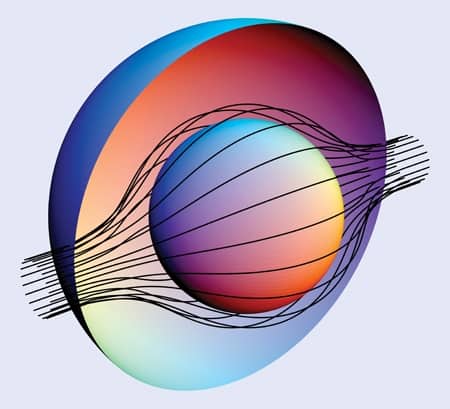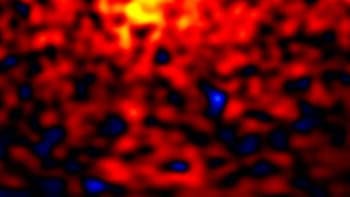He has shown us how to make artificial black holes, levitate objects and even make things disappear. But Ulf Leonhardt of the University of St Andrews thinks we should be wary of promoting “magic” science, as Jon Cartwright finds out.

Most of your research seems to concern the properties of light in unusual materials. Why do you find this interesting?
It’s the analogy between an optical medium and geometry that I find interesting — that a medium can define a space-time geometry in the same way as the gravitational field in general relativity. Some time ago I had to find a subject for a lecture course that would give me some teaching experience. But I had an attack of gout in my foot and couldn’t walk for a week. I spent my time in bed reading The Classical Theory of Fields by Landau and Liftshitz, and it was fascinating. So I thought: this is it, I’m going to lecture on that book. I learned general relativity while giving the lectures, and I simply fell in love with it.
I felt from the start that there must be a connection between light in media and general relativity. But it took me some time to pin it down, to use it to come up with ideas such as making artificial event horizons and unusual geometries for invisibility cloaks.
What can we learn from artificial event horizons?
In a black hole the event horizon — the region beyond which even light cannot escape gravity’s pull — is governed by general relativity and its quantum nature is a matter of speculation. In contrast, my event horizons could be made in analogous systems such as dielectric media, for which the quantum mechanics is well understood. So we can see how the quantum effects of event horizons emerge in an experimental, hands-on physics way.
I started this field of research about nine years ago, and at the moment we are working on experimental projects to make artificial event horizons.
Your research also touches on quantum mechanics in studies of the Casmir effect — for example, you recently showed that it can be used to make objects levitate. Why is this important?
A feature of quantum mechanics is that there is this constant brooding going on in nature — the quantum vacuum. It causes effects that cannot be ignored. Lately there have been fantastic measurements of the Casimir force, which enabled the first real tests of predictions about the quantum vacuum. The fascinating aspect is that these predictions seem to be right on the microscopic scales of the Casimir force but have disagreed with evidence from cosmological scales, where we try to use the quantum vacuum to explain dark energy.
The nimbus of physics as being incomprehensible to the public has partially been an advantage
Of course, you are best known for showing that it is possible to make an object invisible.
Yes, and this is also to do with the principles of the geometry behind optical media, and ideas of general relativity in optics. Essentially you use a material to change the geometry of space-time to create a hole where you can hide things.
Your paper on invisibility was published in Science at the same time as a paper by John Pendry that also gave a blueprint for an invisibility cloak. Who worked it out first?
It is very difficult to say, because in my case the starting point goes back to summer 2002 when I first had the idea of using media that perform co-ordinate transformations for making things invisible. John applied a similar idea to anisotropic media, such as crystals, whereas I focused on isotropic media, such as glass, where transformations are not enough. I found the missing ingredient in September 2005 during a long flight to Mexico. While chatting to my travel companion, explaining invisibility, I suddenly realized that I needed a “non-transformative component” and then worked out everything in my head. It still took some time until I got my theory published — my paper was rejected by all the major journals, because I was careful in not overselling its prospects and perhaps also because I was an outsider in the metamaterials community.
Up to now we can only make cloaks that make an object invisible to light of one frequency. How far off are we from making an object disappear before our eyes?
Again, this is difficult to say, because it will depend on new ideas. It is clear that the present theoretical ideas we have restrict us to a narrow frequency range. This is because you have to guide electromagnetic radiation around a sample, and therefore the phase velocity of that radiation has to propagate faster than the speed of light so it can catch up with the radiation passing alongside it. For perfect invisibility with no disturbances you need an infinite phase velocity of light, which is achievable with certain exotic materials but restricts the cloak to a very narrow range of frequencies. If you accept that simple errors and finite disturbances will exist, however, then I think it’s conceivable that the frequency restriction is no longer true — it’s just a limit of our imagination.
You once said that non-scientists often perceive physicists as people who can perform miracles. Do you think that’s a healthy impression?
Well, that’s the way it is. The nimbus of physics as being incomprehensible to the public has partially been an advantage. We physicists receive a lot of advance credit. Frequently, the more outlandish and incomprehensible theoretical physics appears to be, the more dimensions it has, etc, the higher its standing is. If you were to explain the tricks, as a magician never would, the public might be disappointed.
In the long run, though, I don’t think it’s healthy — we have a duty to the general public to explain and to inform better about how science actually works. But as long as we get interesting devices or applications then there’s a clear case of money well spent. It’s the other aspect of physics, however — seeking to understand the physical world — which is also a good use of public money. Many people are naturally curious about what is going on in the world around them. Science has surprisingly few answers for the very deep and good questions, but it does have some.




